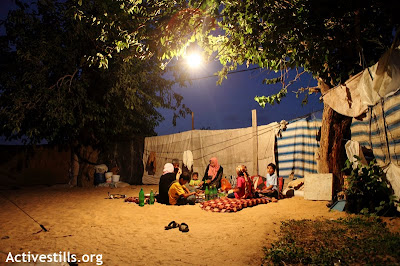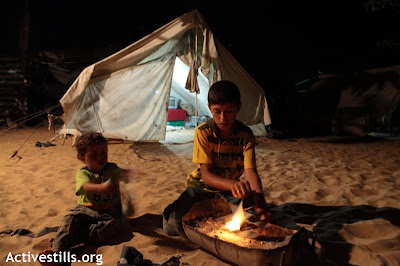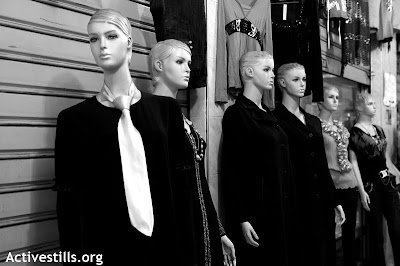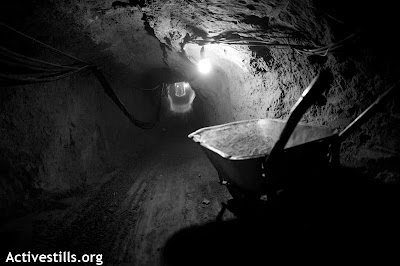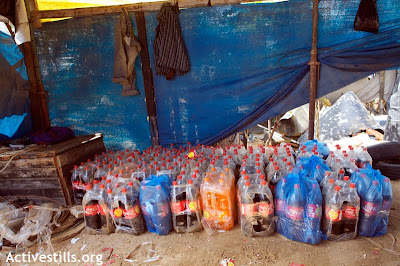




(c) Anne Paq/Activestills.org, Jabaliya refugee camp, Gaza Strip, 25.08.2010
Photos: Bassam Dardouna and another Palestinian stand in the abandoned apartments that they and their families are planning living in.
Bassam Dardouna et un autre palestinien dans les appartements abandonnes qu'ils ont recupere dans un immeuble appartenant au Hamas. Las d'attendre une solution pour leur logement alors qu'ils ont perdu leurs maisons demolies il y a un an et demi, ils ont decider d'investir un batiment laisse a l'abandon par l'autorite palestinienne. le Hamas a indique qu'il allait etudier la question mais allait prendre en compte le fait que de nombreuses personnes ne peuvent reconstruire a cause du manque de materiel de construction.
Eb depit de la rhetorique israelienne sur la levee du siege, les materiaux de construction sont toujours rares a Gaza, et le peu qui rentre ne couvre qu'une infime partie des besoins. De nombreuses personnes vivent encore dans des tentes, des logements de fortune, s'entassent chez des membres de leurs familles ou sont obliges de louer des appartements.
No reconstruction despite siege "easing"Rami Almeghari, The Electronic Intifada, 27 August 2010
"We are not here to steal or take over something which is not our own. We are not criminals or thieves. We are humans who seek a safe shelter after we have lost hope that our houses will be rebuilt," said Bassam Dardouna, 46, head of a 15-member household, as he stood in the middle of an unfinished apartment.
Last week, Dardouna's and more than 35 other displaced families from the al-Salam neighborhood took over the abandoned, partially-built Abu al-Kheir building, a 10-story apartment block east of Jabaliya refugee camp in the northern Gaza Strip.
"For the past year my seven sons and five daughters have all lived in a small rented house in very cramped conditions," Dardouna explained. "I had to stop sponsoring my four sons who are enrolled at the university, as I have become increasingly unable to afford the rent."
Kamal al-Najjar is one of six brothers whose three-story house was completely destroyed by Israeli warplanes during Israel's winter 2008-09 attack on Gaza. Al-Najjar explained that he and his brothers have large families with between seven to nine children and, like Dardouna, could no longer afford to pay rent. "So we decided to move here," al-Najjar explained as he helped a worker fix up the apartment he had taken over.
These Gaza families are among thousands whose houses were either partially or completely destroyed during the Israeli bombardment and invasion. Hamas, which runs the Gaza wing of the Palestinian Authority, reacted to the takeover of the building by saying it would consider that the vast majority of affected people have been unable to repair or rebuild damaged homes due to the lack of building materials.
There has been a chronic shortage of building materials since Israel imposed a crippling blockade on the Gaza Strip more than three years ago. In June of this year Israel announced a partial "easing" of the blockade, under international pressure following its massacre of peace activists aboard the Gaza Freedom Flotilla.
Larger shipments of goods and commodities have entered the territory since Israel has announced relaxing the closure of Gaza. While more consumer goods and foodstuffs are more abundant in Gaza's markets, building materials are still scarce.
Even existing construction projects are stalled due to the persistent Israeli blockade on building supplies. Among them are a major housing project being built by UNRWA, the UN agency for Palestine refugees, in the southern Gaza Strip town of Khan Yunis, and more than 100 UNRWA schools.
"At this moment, there is nothing happening on the ground regarding construction materials for the UN projects," said Basil Nasir, director of the United Nations Development Program in Gaza. When announcing its "easing," Israel had said it would allow supplies in for UN-sponsored projects.
According to Maxwell Gaylard, United Nations Deputy Special Coordinator for the Middle East Peace Process, vital UN projects such as water and sanitation infrastructure and clinics are also on hold.
"Our position is that the blockade in terms of air, sea and land should be lifted and this position has not changed," Gaylard told The Electronic Intifada. Gaylard acknowledged that since Israel announced the easing, about 200 truckloads per day were coming through the Kerem Shalom land crossing as opposed to about 70 before. But this is still far short of what is needed.
"As for housing, schools, sanitation and water, we are talking about tens and tens of thousands of truckloads" of needed supplies, Gaylard said. Gaylard added that the UN was focused on getting permission for more materials to come through and according to him, the Israeli government is trying to expand the capacity of the Keren Shalom crossing.
But Omar Shaban, an economist in Gaza, contends that disallowing construction materials into the coastal territory has nothing to do with logistical factors. He blamed Israel for what he termed collective punishment against of the population in Gaza, a violation of international law.
Israel was forced to announce the easing of the siege following outrage over its attack on the Gaza Freedom Flotilla, Shaban said, "but the siege is not yet lifted significantly as there are also widespread restrictions on movement of people in and out of the Gaza Strip."
According to Shaban, Israel's continued refusal to allow construction supplies into to Gaza is because "If they allow more materials, they think that Hamas will benefit. So they prefer the easiest way of punishing the whole community and by so doing they have failed to separate between Hamas and the rest of the Gaza community."
Shaban added: "I am not saying here that Israel has the right to punish Hamas, because at the end of the day Hamas was elected democratically, so the international community should help Hamas to adapt itself and to be part of a normal political system."
Evidence for this view also came recently when Israeli deputy prime minister Silvan Shalom told Quartet Envoy Tony Blair that Israel would not supply additional electricity to Gaza -- which suffers from severe shortages -- because that would "benefit Hamas.
"I think Israel wants to keep Gaza under pressure as a poor area while Palestinians are divided into two leaderships -- one in Gaza under Hamas and the other in the West Bank under the Fatah-dominated Palestinian Authority. Such a division gives Israel the excuse to do nothing towards changing the status quo, especially rehabilitation of the war-torn Gaza," said Shaban.
Bassam Dardouna and Kamal al-Najjar might have finally found some comfort in the abandoned building, but the needs of thousands of other displaced families remain unmet.
"Since we have been displaced, we have received many promises. We have increasingly felt we have been already deserted," Dardouna said.
Rami Almeghari is a journalist and university lecturer based in the Gaza Strip.
